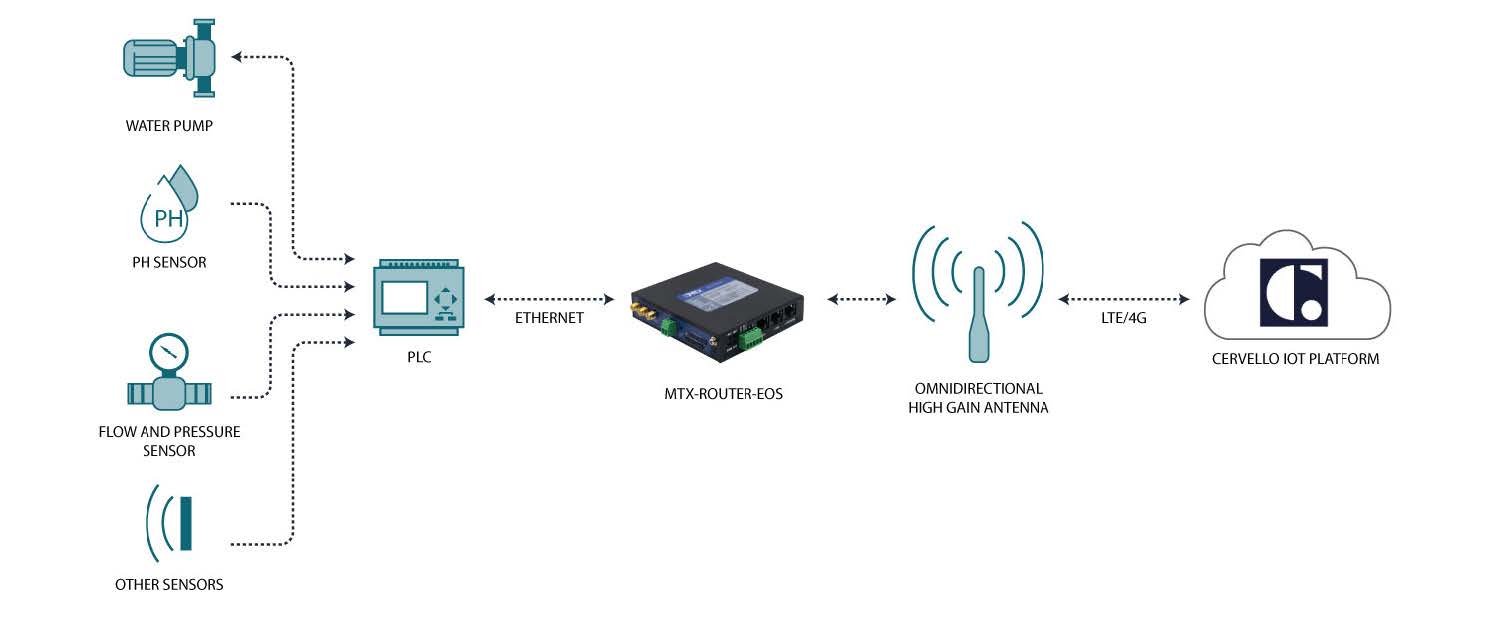Water Monitoring in Rural Environments
When it comes to getting the most out of an agricultural facility, one of the main challenges is to be able to monitor and control them remotely, being able to obtain all the information on water quality as well as being able to control consumption and act, remotely, about the water pumps. This challenge becomes even greater if we take into account that some of the facilities will be in poor coverage environments, which is why a solution that provides connectivity security is essential in order to reduce travel, thus increasing the efficiency of the facility.
Device: MTX-Router-EOS, compact industrial IoT router with LTE, dual SIM and 3x Ethernet
Platform: Cervello Stem IoT Platform
The rural water monitoring project is usually made up of several elements. The first of these is the installation itself, which has different sensors that allow controlling water quality (conductivity, PH, temperature, etc.), consumption (flow, pressure, etc.) and a pump that works by extracting water when be necessary. On the other hand, an element is necessary that provides connectivity to the installation and that allows, remotely, to access all this information and act, if necessary, on the water pump. Finally, the last and essential element is an IoT platform where all data can be received and from where actions can be carried out on the devices of the set both automatically and manually. In the case study in which we find ourselves, we will solve these last two elements.
In order to provide connectivity to the installation, we must bear in mind that it is made up of various sensors and a water pump, all of them connected to a PLC which is the one that gathers all the information and allows action on the water pump. This PLC usually has an Ethernet output through which all data can be obtained. We must also take into account the special coverage and connectivity conditions that the facilities may have. Not surprisingly, these are installations in rural settings where coverage is poor or frequently fails. To solve all these requirements, the most suitable device would be an MTX-Router-EOS, since it has three Ethernet inputs (being able to connect up to three PLCs with the same device) and LTE/4G connectivity, in addition to dual SIM (being able if necessary, to use two SIM cards from different operators to ensure connectivity in case of coverage failure). On the other hand, in rural environments or locations with little coverage, it is appropriate to use special antennas that allow the weak available LTE/4G radio frequency signals to be amplified to the maximum. In these cases, the use of high gain omnidirectional fiberglass antennas or directional antennas of the panel or yagi type is suitable.
Finally, the Cervello Stem IoT platform allows the information received from the PLC to be received, stored and displayed on different dashboards (with tables and graphs). In addition, Cervello can send commands and setting parameters to the PLC, being able to act remotely on the operation of the water pump. All of this two-way communication is done through the MTX-Router-EOS.
Thanks to this solution, based on an MTX device with LTE/4G connectivity and three Ethernet interfaces, which also provides reliable connectivity with its dual SIM and the use of an external high-gain LTE/4G omnidirectional antenna, monitoring and water management in rural settings is much simpler and, above all, efficient. Thanks to IoT technology, trips to remote facilities in rural settings are avoided, facilitating their management and reducing maintenance and operating costs.




